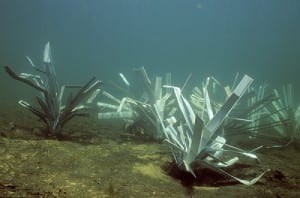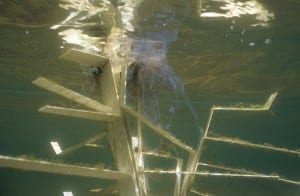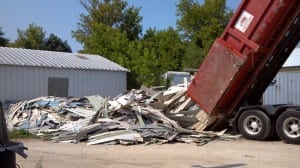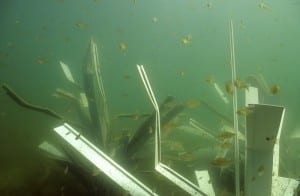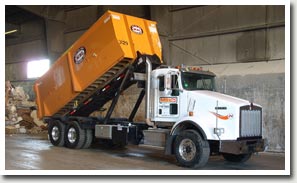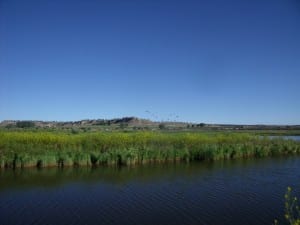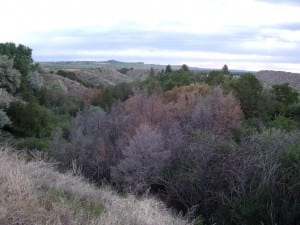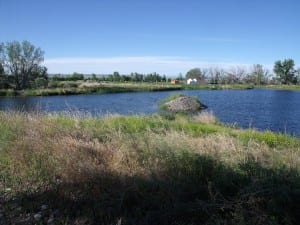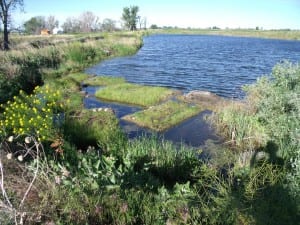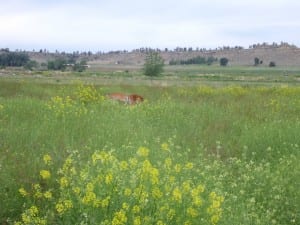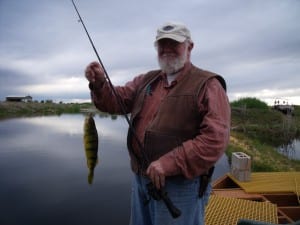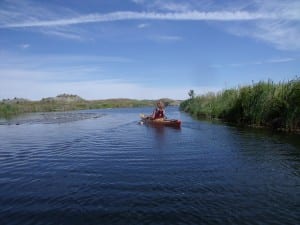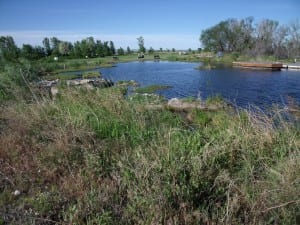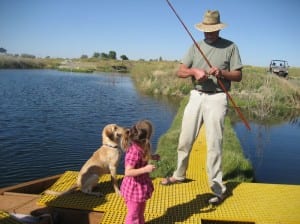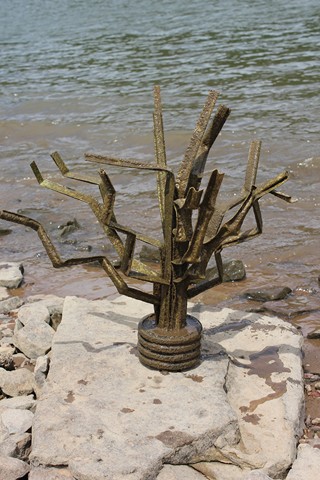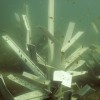Bringing Back the Fish: Michigan Sea Grant Oversees Successful Habitat Reconstruction |
| By Stephanie Ariganello, Michigan Sea Grant The unmanned camera bounced along a rock reef on floor of the St. Clair River. Researchers watched the monitor. Then a long, dark shape came into focus and another and another. The looming figures were lake sturgeon. The team whooped at the discovery: the restoration was working and much sooner than anticipated. The goals of the project are to:
“It is science in action,” said Jennifer Read, assistant director of Michigan Sea Grant and project lead on the St. Clair River Middle Channel Restoration project. “This is the kind of research project where we’re performing research not just to learn new things, but to apply what we’ve discovered. And with this project, we’ve been rewarded with early success.” The lake sturgeon were congregating on rock reefs installed as part of the restoration project in the St. Clair River, led by Michigan Sea Grant. The project focuses on restoring fish spawning habitat in order to add young fish to the stocks of several endangered or threatened fish species in Michigan, including lake sturgeon, mooneye, northern madtom catfish and river redhorse suckers. Valuable commercial and sport fish such as walleye, lake whitefish and perch are also expected to use the reefs for spawning. “Obviously there was a need for more spawning habitat based on the immediate response by the sturgeon,” said Terry Heatlie, habitat restoration specialist with NOAA Fisheries Restoration Center, Great Lakes Regional office. “It’s special because this would not have happened without the restoration project, without restoring spawning habitat in the river.” click to expand image  Reef habitat restoration in the St. Clair River Middle Channel. Credit: Michigan Sea Grant Reef habitat restoration in the St. Clair River Middle Channel. Credit: Michigan Sea GrantWhen given enough time, Heatlie said, some land or water issues heal themselves. With habitat restoration, that is not typically the case. It requires intervention. The construction was completed in June. Nine rock reefs were created, providing an acre of restored fish spawning habitat in the river. The St. Clair River connects the waters of Lake Huron to Lake St. Clair, where water then flows through the Detroit River and eventually into Lake Erie. The channel is a major shipping route and forms a border between the U.S. and Canada. Because of its location in the heart of the Great Lakes, the restoration has potential to benefit waters upstream and downstream of the construction. The restoration efforts could also provide cultural and economic benefits, bolstering commercial and sport fishing and contributing to a higher quality of life in an area currently listed as an Area of Concern under the U.S.-Canada Great Lakes Water Quality Agreement. See the dozens of unique artificial fish habitat models, fish attractors and fish cover at fishiding.com, the leader in proven science based, fish protection. In the early 1900s, the rivers connecting Lakes Huron and Erie were widened and deepened to accommodate larger, modern commercial shipping vessels. Dredging and depositing the materials in different locations in the river damaged fish spawning sites — and subsequently, fish populations. click to expand image  Researchers inspect egg mats as part of the Middle Channel Restoration project. Credit: Michigan Sea Grant Researchers inspect egg mats as part of the Middle Channel Restoration project. Credit: Michigan Sea GrantTo compensate for the habitat loss, Michigan Sea Grant and project partners (U.S. Geological Survey, Michigan Department of Natural Resources, U.S. Fish & Wildlife Service, the University of Michigan, NOAA, SmithGroup JJR andMichigan Wildlife Conservancy) constructed two reef projects previously in the Detroit River. The location and design of the Middle Channel reefs were chosen based on studies of fish populations and lessons learned during the previous projects. “That’s what is really unique about the Middle Channel project,” said Read. “It reflects over ten years of work performed by a multi-agency science team tackling increasingly complex questions over a large geographical area. It represents a successful, system-wide approach to restoration.” Researchers surveyed the new reefs and collected eggs. It was confirmed. Lake sturgeon successfully deposited and fertilized their eggs on the reefs and the eggs produced viable sturgeon larvae. Post-construction assessments are planned to ensure the Middle Channel Reefs are being used by a variety of fish species. The goal, aside from reestablishing the habitat, is to help remove the St. Clair River from the bi-national list of Areas of Concern. Two more spawning reefs for native fish are being planned for the St. Clair River in 2013 and 2014, as part of the Great Lakes Restoration Initiative. |
Tag: pvc fish habitat
Wood habitat in Table Rock rotting away after 50 years underwater
This unusual barge can deposit several tons of rock into the lake to help create new fish habitat. / Missouri Department of Conservation
Written by
David Casaletto
Executive Director, Ozarks Water Watch
Table Rock Lake is more than 50 years old.
When the lake was created, much of the Ozark forest was flooded, and the trees and brush provided cover for the lake’s fish populations. But after 50 years, most of that fish habitat has disappeared.
In 2007, the Table Rock Lake National Fish Habitat Initiative (NFHI) project began with the primary objective to improve fish habitat in Table Rock Lake. Additional goals include: Improve the water quality of Table Rock Lake and its tributaries, monitor the effectiveness and longevity of habitat structures, and develop a framework for a broader national habitat program.
Project partners include the Missouri Department of Conservation, Arkansas Game and Fish Commission, the National Fish and Wildlife Foundation, Bass Pro Shops, The U.S. Fish and Wildlife Service, the U.S. Army Corps of Engineers, Southwestern Power Administration, Ozarks Water Watch, Table Rock Lake Water Quality, James River Basin Partnership and other private groups and citizens.
To improve habitat, the Initiative project places cedar trees, hardwood treetops and recycled Christmas trees in the lake to create habitat with a “fish habitat barge.” The barge was built for this purpose by Tracker Marine in Lebanon, Mo. It is a large pontoon-style boat with a hydraulic lift on the front that raises and dumps the habitat into the lake.
Another barge called the “rock barge” is contracted to place larger (and heavier) habitat structure consisting of rocks, boulders and stumps. The state conservation department gets these materials from developers, contractors and landowners who are clearing land and need to dispose of them.
To date, 1,810 brush piles, 104 rock structures, 76 stump fields, 11 stump/rock combinations and 26 rock “fence” structures have been installed for a total of 2,027 new habitat structures in Table Rock Lake. These structures were placed in areas and depths that are available for fish during most of the year.
They have been located by positioning systems and can be found (and downloaded) on the department’s website at:http://newmdcgis.mdc.mo.gov/tablerock/. In addition, the department has placed green signs on the shoreline near some structures.
The Initiative also recognizes that water quality is a critical component of fish habitat. Funding has been contributed to the James River Basin Partnership, Table Rock Lake Water Quality and Ozarks Water Watch for cost sharing to homeowners to pump out septic tanks and replace failing septic systems.
These water quality organizations have combined over the past five years to pump out more than 2 million gallons of septic effluent and replace more than 100 failing septic systems.
All participants receive a packet of water quality educational materials and septic system maintenance information. Funds are still available to share the cost for pumpouts and for replacing failing septic systems.
See the dozens of unique artificial fish habitat models, fish attractors and fish cover at fishiding.com, the leader in proven science based, fish protection.
To monitor and evaluate the Initiative structures that have been placed in Table Rock Lake, the state conservation department has designated four evaluation techniques: fish sampling, Scuba observations, an angler survey and a black bass biotelemetry study.
By monitoring fish use of the habitat structures, the department is learning what techniques and designs work best for placing habitat during the remainder of the Initiative project and in other lakes in Missouri. Information gathered from the evaluation will allow the department to share ideas and techniques with other state agencies that are working to improve fish habitat in reservoirs.
By all accounts, this is a success story, but is that area going to be loaded with fish? Will a fisherman always be able to find fish off those trees? The only way to find out is to get out there and fish those areas. And the only way for biologists to know if the project is working is if anglers let them know.
Visitthe Missouri Department of Conservation websiteand download the GPS points, print off a map and go fish.
Texas tree top habitat causes Govenor intervention.
Dear friends,
I was recently contacted by J Harmon, President of the Protect lake Dunlap association in New Braunfels,Texas. He explained to me their struggle with the Guadalupe-Blanco River Authority over existing small diameter standing timber being hazardous to recreation use. Apparently, The GBRA has denied the cutting of these stumps to protect fish habitat and recommends marking these areas off to boat use which has the residents upset.
See the dozens of unique artificial fish habitat models, fish attractors and fish cover at fishiding.com, the leader in proven science based, fish protection.
The PLDA’s plan is to draw down the reservoir and shorten the existing hazards about eight feet from normal surface elevation. I’m told there are hundreds of them and already have caused many accidents and property damage. J says the average depth is about 15 feet, so when cut, they would still stick up about 6-8 feet off the bottom, root ball intact.
After cutting, they plan to set one of our PVC habitat units on the remaining stump and fasten it there for good. This would increase the square footage of surface area approximately three times. The thinking is, with our units within six feet of the surface as water fluctuates, boats, skiers and water craft will be safe, including the fish. J and the group understand the benefits of not only keeping as much existing habitat as possible but to continue to add more habitat. The cut off tops would be kept and fastened to the remaining trunk too.
They have a full understanding of the science behind periphyton, nutrient removal and fish production and feel unwavering in their decision to work with only us in their efforts.
Senator Jeff Wentworth supports PLDA. With his intervention and the phone call from Gov. Rick Perry, GBRA’s action item #8 was tabled. The PLDA has been granted 30 days, (less now) to present their case for a final decision of what will be allowed. The General Manager and staff continue to meet with representatives of Lake Dunlap, enforcement officers, and fishery experts to evaluate the current no-wake area designation and alternative options to provide water safety and assure a balance of all uses including the preservation of fishery habitat and funding mechanisms, and to continue to review and develop alternatives that address congestion and lake boating conflict uses on Lake Dunlap and to report back to the Board at its next regularly scheduled meeting in August 2012.
What I’m asking of you once again is your opinion, hopefully your support. Can you find any adverse effects of removing these hazardous stumps as long as the habitat is replaced in other ways/forms? Can you comment on the benefits of the artificial habitat we produce and results you have seen? What can we expect to see in a 300 % increase in available cover for the fishery? With our help, the PLDA intends to present their plan for approval as a landmark decision for the state of Texas. Safety for the residents and fish is the priority of both sides, in that order. All parties involved want to save and increase fish habitat. Wood is good, just not where people get hurt. Send replies to either Jarod or myself at david@fishiding.com Thanks.
Here are some links to the information as well as Jerod Harmon’s contact information:
news story:
http://www.ksat.com/news/Lake-Dunlap-res…rz/-/index.htmlhttp://www.plda.org/index.htmlhttps://docs.google.com/viewer?url=http%3A%2F%2Fwww.plda.org%2Ffiles%2Fstump_removal_procedure.pdfhttp://www.gbra.org/
jrharmon123@yahoo.com
713-202-8870
Fish habitat crusader awarded Churchill Fellowship
Craig Copeland – working to save our fish habitat. Image NSW DPI
CRAIG Copeland, Manager of the Conservation Action Unit within the NSW Department of Primary Industries (DPI) has been awarded a prestigious Churchill Fellowship to investigate the motivation of recreational fishers in the US, UK and Ireland to restore fish habitat.
“Craig, who is based at Wollongbar, is highly regarded throughout Australia for his work in aquatic habitat rehabilitation,” said NSW DPI Director General Richard Sheldrake.
“He has led the pioneering unit responsible for fish habitat rehabilitation in NSW which has resulted in massive improvements to fish habitat and fish populations through initiatives such as fishway construction, weir removals, fish-friendly road crossings, floodgate management, riparian revegetation and river resnagging programs.”
Copeland’s work in educating and engaging the broader recreational fishing community on habitat issues is proving successful with some of the larger recreational fishing groups through the establishment of the Fish Habitat Network program.
Dr Sheldrake said the Fellowship will provide an opportunity for Mr Copeland to travel to countries in the Northern Hemisphere where recreational fishing groups and individual fishers are the principal players in restoring fish habitat. See the dozens of unique artificial fish habitat models, fish attractors and fish cover at fishiding.com, the leader in proven science based, fish protection.
“By interviewing fishers in these countries, Craig will get to understand their motivations and capacities – and bring back expertise aimed at increasing the capability of Australian recreational fishers to support and improve their fishery.
“The lessons learned will be immediately transferred to recreational fishers and habitat managers here in NSW.”
Copeland said the sustainability of recreational fishing and the capacity of the sector to grow are dependent on healthy fish stocks.
“Over three million people fish recreationally each year making it one of the most significant outdoor activities undertaken by Australians,” he said.
“There is great scope to significantly increase the proportion of recreational fishers in NSW who contribute time, funding and effort to rehabilitate fish habitat and, as a result, increase fish populations.”
Copeland plans to undertake his Fellowship trip in early 2013 and will report back to the
recreational fishing community later in the year.
The Winston Churchill Memorial Trust, which was established after the death of Sir Winston
Churchill in accordance with his final wishes, has now funded more than 3,700 Fellowships for Australians. http://www.fishingworld.com.au/news/fish-habitat-crusader-awarded-churchill-fellowship
MBL Recycling provides vinyl siding for fish habitat…by the tons!
Started in October 2002 with just one truck and 30 boxes, Wendy Gold and her brother Robert Lenzini have modeled the foundations of their family’s generational business, Lenzini Excavating, initiating 37 years ago, into today’s MBL Recycling, established as an operation that specializes in the recycling of construction waste and demolition debris. Slowly but surely, the company has modestly added to its fleet, which now counts to eight trucks and close to 400 boxes.
Over time, the company has grown from its initial days of hand sorting to separate the waste material to a state-of-the-art facility that brings efficiency to the sorting process and new levels to both volume and productivity. The facility current stands at 41,000 square feet.
Based in Palatine, Ill., where the company’s new facility was developed in 2005, MBL Recycling offers full roll-off container services to its customer base, offering anywhere from 10 to 30 yard containers. The recycled material sorted, processed, source separated and is then sold back to the market. For example, recycled shingles are turned to asphalt in order to construct city roads. In 2007, MBL Recycling added concrete washout containers to its extensive line of services, further improving its position in the marketplace, tackling the market with a different style box, while the boxes also better comply with growing environmental standards.
Programs and services
The addition of 11,000 square feet to its new material recovery facility allows plenty of space for future growth.
And as its volume has continued to grow, MBL Recycling has seen an increase in incoming streams from diversifying construction projects, further adding to both the demand and specification of the waste separation. Because of such a high volume with its customers, MBL Recycling was able to hold its percentage in the market as the company successfully navigated the impact of the global economic downturn, which was specifically damaging to the American housing economy.
Business development
“Construction is really down here. Housing has come to a halt. We were pretty fortunate though because we never really focused much on housing,” said Robert. “We did a lot more commercial and it has slowed down…but nowhere near the housing.
“Will next year be any better? It is still too early to tell. We see it from an excavating side because we can tell when they bring in bids and how much work is there for the spring, and there isn’t much,” added Robert, illustrating that the excavating business allows for a unique secondary insight into the future.
“We pinch ourselves everyday that we are here and still going. We are riding the storm and doing everything status quo until everything bounces back. We’re always thinking of new things, but we have a couple hurdles here in Illinois that we are trying to work on now too (like getting into the drywall recycling market),” said Wendy.
“We were able to pick up some of the slack from some of the other guys that were in the housing market. The shingles this year also brought our tonnages way up,” said Robert. “Before we used to have to ship [the shingles] to Wisconsin and they used them in asphalt mix. Just in the last year, Illinois recognized this and got a standard for it.”
“We do a lot of work with Power Construction (based in Schaumburg, Ill.), a high profile contractor. We do a lot of hospital additions. We just finished the Northwest Community Hospital nearby and that was a huge project. Astellas Pharma is another Power Construction job. It’s a three-year project that just started this year,” said Wendy.
But right now our only out is that we recycle our own stuff, so that is our little niche.” Associated with the U.S. Green Building Council, MBL Recycling provides all LEED documentation for its customers, generating environmental sustainability reports on a monthly basis.
The transition to ‘go green’ is something that is becoming a “really big thing with the general contractors…they love to recycle, especially with some of the locations around us,” said Wendy. “Hooray for Chicago because they mandate 50 per cent recycling of construction. It is wonderful that they recognize that.”
As such, in 2009, the Illinois Recycling Association recognized MBL Recycling as the Recycler of the Year.
Quality customer service
MBL Recycling prides itself on providing the best possible service to its customer base.
“Service is a big thing nowadays. People call and they want their stuff. It is not all about the pricing because at least when people call us they know we are going to be there,” said Robert.
“People are so thankful. You would be surprised at the phone calls—people go out of the way to call here and say something nice about one of our drivers, or for us being there in a pinch. Everyone gets the feedback and gets to feel good about things,” said Wendy. “We treat all of our customers the same—like gold.”
WWW.MBLRECYCLING.COM
http://www.youtube.com/watch?v=rv3M4zUsU5U&feature=player_embedded
 MBL is committed to environmental best practices and sustainability. MBL diverts millions of pounds that would normally go to landfill in your C&D container. MBL is taking C&D recycling to the next level. Diverting waste from landfills, promoting reuse and recycling in our community.What is your Current C&D waste management plan?
MBL is committed to environmental best practices and sustainability. MBL diverts millions of pounds that would normally go to landfill in your C&D container. MBL is taking C&D recycling to the next level. Diverting waste from landfills, promoting reuse and recycling in our community.What is your Current C&D waste management plan?Are your crews taking the time to separate each and every item and put them in separate containers for disposal?
 Do you have multiple containers to handle the variety of materials to be disposed?
Do you have multiple containers to handle the variety of materials to be disposed?Or are you already putting jobsite C&D debris mixed into one container?
MBL Recycling is ready to handle your C&D waste. Mix all C&D waste into one container. Do not incur the extra time and cost of separating materials yourself. No need for extra job crew training: just explain you will be recycling.
 Just direct ALL your C&D materials to MBL!
Just direct ALL your C&D materials to MBL!
MBL will take your C&D container and separate the recyclable materials for you. On average 75% of every C&D container is recycled. Allow us to recycle your construction and demolition debris, diverting tons of material from landfills.
 An alliance of professional environmentalists working to promote greener solutions. Find us atwww.thegreenteamchicago.com.
An alliance of professional environmentalists working to promote greener solutions. Find us atwww.thegreenteamchicago.com.
$4 million habitat project for fish at Colony Farm

Juvenile salmon will have more protected habitat to get a good start in life thanks to a $4 million habitat enhancement project now nearing completion at Colony Farm Regional Park.
Environment Minister Terry Lake will be celebrating the near-completion of the project today, Monday, with members of the Kwikwetlem First Nation who were key to its development
Lake will join Metro Vancouver Environment and Parks Committee Chair Heather Deal and Kwikwetlem First Nation Chief Ron Giesbrecht in a ceremony to welcome the salmon, unveil a new interpretive sign on the Colony Farm walking path and showcase the habitat enhancement work.
The project, located on the “Wilson Farm” portion of Colony Farm Regional Park, has build a vital habitat for juvenile salmon and restored tidal function to a part of a river traditionally ranked high in the Outdoor Recreation Council’s ‘Endangered Rivers List’.
“This project went a long ways to addressing a major limiting factor to the production of salmon in the Coquitlam River,” said Dr. Craig Orr, environmental consultant to the Kwikwetlem First Nation in a press release. “Urbanization has claimed much of the juvenile salmon habitat in the lower Fraser River area, and this project aimed to restore a large part of that critical habitat.”
The Wilson Farm project, a negotiated highway construction mitigation project funded by the provincial Gateway Transportation Project, has deepened and expanded existing channels for juvenile fish, replaced old tidal pumps with newer and fish friendly pumps, and added cool groundwater to allow fish to survive better. The project was planned with help from experts from the Department of Fisheries and Oceans Canada and the private sector, and input from the public. It was also designed to have minimal impacts on the old field habitat of Colony Farm Park and its associated wildlife.
See the dozens of unique artificial fish habitat models, fish attractors and fish cover used at fishiding.com, the leader in proven science based, fish protection.
The project received complaints from Burke Mountain Naturalists but went ahead with public consultation.
dstrandberg@trictynews.com
Outdoors: A lesson learned
Webster Lake weed kill devastates plant life.
Eat more fish to clean your lake?
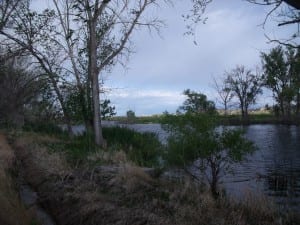 A few weeks ago, my wife Renee’ and I took a trip to Shepherd Montana, headquarters of Floating Island International Inc. We had been invited to stay on the ranch and to see for ourselves how Bruce Kania and his wife Anne, are growing huge fish fast with a woven matrix of inert substrates called BioHaven, or Floating Treatment Wetlands. I had been in contact with Bruce for some time, learning about how excessive nutrients brought in from runoff can be turned into fresh, tasty fish. Not only do the Kania’s grow fish, but frogs, minnows, pheasant, deer and all species of waterfowl prosper in their efforts. Even Yellowstone cutthroat trout flourish in this superior environment, along with crappie and perch and various minnows.
A few weeks ago, my wife Renee’ and I took a trip to Shepherd Montana, headquarters of Floating Island International Inc. We had been invited to stay on the ranch and to see for ourselves how Bruce Kania and his wife Anne, are growing huge fish fast with a woven matrix of inert substrates called BioHaven, or Floating Treatment Wetlands. I had been in contact with Bruce for some time, learning about how excessive nutrients brought in from runoff can be turned into fresh, tasty fish. Not only do the Kania’s grow fish, but frogs, minnows, pheasant, deer and all species of waterfowl prosper in their efforts. Even Yellowstone cutthroat trout flourish in this superior environment, along with crappie and perch and various minnows.
See the dozens of unique artificial fish habitat models, fish attractors and fish cover used at fishiding.com, the leader in proven science based, fish protection.
The setting was breathtaking, Mule deer and whitetail browsing on the thousands of perennial plants Bruce has planted for their benefit and soil stability. Over time these plants die off and return each spring, contributing to the rich organic soils being built up. Sprawling channels and wetlands run throughout the property, slowly beginning to filter and absorb the high levels of nutrients. When the water enters the property, it is dark and cloudy like chocolate.
Ducks of all varieties, geese, snipe, vulture, pheasant and more, have taken up residency in this oasis of prime habitat, with no intention of ever leaving. With Bruce being a veteran trapper, predators are being kept in check, protecting the desired species. With the Yellowstone River along one property line, this place is an outdoorsman’s paradise.
Stewardship of our natural resources is the core of the work being undertaken at Shepherd Ranch. We were there to catch and eat a bunch of these fish, helping them ultimately remove the phosphorus and nitrogen that causes excessive weed growth and poor water quality. Bruce and I dreamed big about someday soon, this concept of abundant, mass fish harvest to clean our Nation’s waters and beyond.
The data shows that over 50% of our Nation’s waterways are considered eutrophic and in trouble, meaning highly excessive weed growth and nutrient concentrations. Dark, stained and sometimes smelly water are all results of an unbalanced system. More information about our Nation’s waters are available on the National Fish Habitat Action Plan website, a wealth of details everyone is affected by.
When we began producing artificial fish habitat products made from reclaimed PVC siding called Fishiding, the ability to grow algae immediately on the inert surface area, appealed to the fisherman. Like myself, the average fisherman understands that habitat with good algae growth seems to hold more fish. It wasn’t until reading more and talking to Bruce that I began to understand the big picture of why this holds true.
These nutrients stick to surfaces underwater and create the beginning of the food chain called periphyton. Many forms of this wonderful natural, filter and food factory are present. Algae, bacteria, fungi, protozoa, zoo plankton and other invertebrates, function as a community highly efficient in capturing and processing nutrients. When I say processing, this means turning it into food of the highest quality found on earth. The more fish graze on it, it grows faster, decreasing bio mass and the fish grow at alarming rates, making the water clearer.
Numerous types of periphtyon are present, some require light to thrive and some do best in the dark. The more surface area available, the more periphyton can grow and work its magic. Pretend the floating island is a supermarket, the more shelves available the more food can be stocked for consumption. Small fish and fry eat this “super food” until about age one, when they begin to forage on larger minnows and bugs. Periphyton is the “mother’s milk” needed to start life full of nourishment.
This process has been perfected in second and third world countries. We are lacking in knowledge here in the states, but it’s improving with over 4400 of these floating treatment wetlands installed here and worldwide.
Think about all the ponds and lakes in your area. Golfcoarse ponds, retention ponds, private and public, there are many. Some are clear and deep with a balanced mesotrophic or oligotrophic eco system. The other 50% eutrophic waters, could be teaming with fish and every citizen is asked to help keep them clean…..by catching as many fish as you can eat, and removing them! The fish also reproduce faster than normal, so there is no worry of running out. Fish Fry Lake is living, thriving proof of this for all to see. Renee’ and I caught over 500 fish in less than eight hours of fishing. If your hook was in the water, it was being attacked by one or more gorgeous perch or crappie. From 6-8” one year olds, to 12-14” plus jumbos! Remember, this is in Montana not Lake Michigan, the only other place I have ever seen perch of this size. Perch and Crappie were abundant to say the least, with a perch containing about one percent live weight of phosphorus. The name “Fish Fry Lake” more than lives up to its name. Remember, this works with no chemicals, win,win,win…….
This natural cause and effect has other uses too. Bioswales also made by FII, are used in ditches and swales to slow down erosion as water runs through it, similar to adding hay bales in a ditch after new construction. The difference in using the inert matrix, patented by FII, is that as the bioswales slow down the water, the periphyton forms and begins to consume the over abundant nutrients, cleaning the water as it passes through slowly. Unlike the hay bales, the matrix never breaks down, which would add to the nutrient load in the waterway. Same with weeds, as they decompose, they remove oxygen from the water and add fertile organic matter that acts like fertilizer. Inert substrates like the matrix material used in the Floating islands, never breakdown and keep working year round to feed the fish and clean the water.
One of the optimal ways that FTWs can transition nutrients from water to beneficial use is to grow bacterial biofilm rather than floating algae. Bacterial biofilms grow faster than algae when their limiting parameters are satisfied, and when they have adequate circulation and surface area for growth. With appropriate stewardship, they also are an improved primary food source for fish (Azim 2005).
Circulation increases bacterial efficiency by bringing nutrients such as dissolved oxygen, nitrogen and phosphorus to the biofilm.
A single 1000-square-foot BioHaven Floating Island can provide over 18 acres of strategic “concentrated wetland effect” surface area.
As demonstrated in field-scale case studies, waterways containing FTWs remove contaminants (pollutants) such as ammonia, total nitrogen, total phosphorus, Total Organic Carbon (TOC), Biochemical/Chemical Oxygen Demand (BOD/COD) and total suspended solids (TSS). These studies have included municipal wastewater, storm water, lakes and agricultural runoff. FTWs have demonstrated the ability to simultaneously remove all of these contaminants, due to their complex biofilms containing both aerobic and anoxic bacteria.
Dissolved oxygen (DO) levels are higher when inert substrate are used rather than organic substrates like wood, due to oxygen consumption during organic carbon uptake by biofilms. Inert substrates like BioHaven polymer matrix, can provide a more precise ability to initiate movement of a waterway’s nutrient load up the food chain. Periphyton moves nutrients up the food chain better than does synthetic fish food.
The bottom line is this. To ultimately remove these unwanted nutrients, fish have to be harvested. Not all lakes have these issues, but in Eutrophic lakes, the fish contain these nutrients and have to be caught and eaten to keep up with the periphyton growth. A perch for example, contains about 1% live weight of phosphorus. By removing enough fish to equal one pound of this chemical which is safe for humans and needed for strong bones, about 700 pounds of aquatic vegetation never gets a chance to grow. No chemicals or weed harvesting just fishing and keeping them for the table. Would you be willing to help clean your neighborhood pond by catching and eating some fresh fish? It’s a reality and is being performed at an alarming rate at Fish Fry Lake. We flew home with only one checked bag, 50 pounds of fresh fillets.
Clean water entering the Yellowstone River and ultimately the Mississippi, Stewardship is the lesson to be learned.
Pro’s opinion after one year…Artificial fish habitat rocks!
See what professional fishing guide, photographer and accomplished writer Brad Wiegmann, has to say about fishiding habitat products.
Adding Artificial PVC Fish Attractors with Fishiding
See the dozens of unique artificial fish habitat models, fish attractors and fish cover used at fishiding.com, the leader in proven science based, fish protection.
PVC fish habitat excels in giving fish what they require-Underwater pictures update
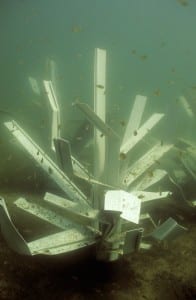
This next group of amazing shots by Engbretson Underwater Photgraphy, show biofilm and algae growth explode after less than four weeks. Fishiding Reclaimed Artificial Fish Habitat products made from reclaimed pvc vinyl siding, act as an ideal inert substrate to grow biofilm which in turn feeds and grows fish at a far above normal or average rates. This process called biomimicry, has been perfected and installed with overwhelming success by a company called Floating Island International, which utilizes recycled plastic matrix to create massive amounts of surface area.
See the dozens of unique artificial fish habitat models, fish attractors and fish cover used at fishiding.com, the leader in proven science based, fish protection.


